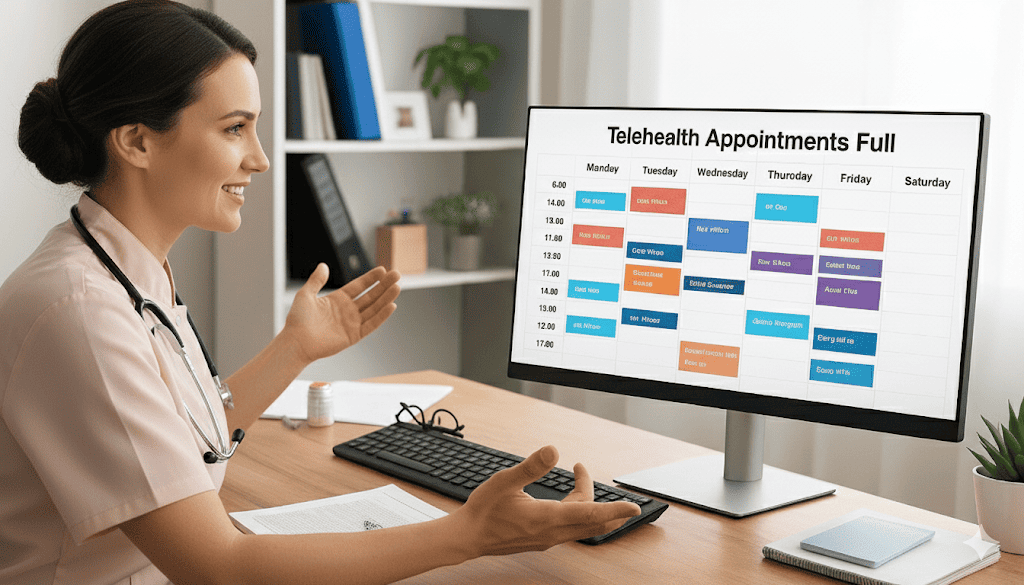Best HIPAA-Compliant Telehealth Platform for Tebra Users
💡 Choosing the best HIPAA-compliant telehealth platform for Tebra users is crucial. At minimum, it must improve patient access, reduce no-shows,...
6 min read
Gregory Vic Dela Cruz : Sep 24, 2025 4:00:00 PM

Table of Contents
Telehealth is no longer optional for today’s small and independent clinics. Patients expect convenient, flexible ways to access care. Practices that fail to deliver risk losing patients to competitors. For practices using Practice Fusion, the opportunity is clear. It's imperative to integrate a HIPAA-compliant telehealth solution directly into your EMR.
The rise of virtual care has been driven by multiple factors. As the pandemic accelerated adoption, patients embraced the convenience of remote visits. Providers saw efficiency gains from digital follow-ups. Today, virtual care is part of mainstream healthcare delivery. However, not all telehealth platforms are created equal.
Consumer video apps like FaceTime or free Zoom accounts might seem convenient. However, they lack encryption, Business Associate Agreements, and audit trails required for compliance. Small clinics must prioritize security, compliance, and integration when choosing a platform.
This article serves as a comprehensive guide to adopting telehealth for your clinic. We’ll explore why telehealth is critical for growth. We will also dive deep into what makes a platform compliant and the features that matter most.
Ready to learn how you can make the most of telemedicine? Let's jump in.
Patients want convenient ways to access healthcare. Telehealth Practice Fusion HIPAA-compliant solutions meet this demand by enabling secure virtual visits that patients can join from home, work, or on the go.
Many patients in rural areas face long drives or limited transportation. Secure virtual visits for small clinics expand access and ensure underserved populations receive the care they need.
Offering telehealth differentiates a clinic from competitors and supports growth. Practices that integrate HIPAA-compliant telehealth solutions with Practice Fusion see increased patient volume and higher retention.
Travel challenges and last-minute conflicts often cause no-shows. With telehealth, patients can attend appointments virtually, significantly reducing missed visits and stabilizing practice revenue.
Chronic disease management and follow-up visits are easier with telehealth. Patients stay connected to their care team, which improves outcomes and keeps treatment plans on track.
Patients value flexibility and time savings. Telehealth technology for independent practices improves satisfaction, making patients more likely to return and recommend the clinic.
Telehealth became vital during the pandemic and remains a key strategy for reducing exposure to contagious illnesses. Secure virtual care keeps patients and providers safe while maintaining access to care.
Telehealth reduces overhead for clinics by lowering the need for physical space and resources. Patients save on travel costs and time away from work, making healthcare more affordable overall.
Providers can manage their schedules more efficiently with telehealth. Virtual visits allow for quicker check-ins, better management of appointment gaps, and increased capacity without extending hours.
When combined with an EMR-integrated telehealth platform like Practice Fusion, telehealth supports digital-first workflows such as online intake, secure messaging, and automated reminders. This creates a streamlined, modern patient experience.
These ten reasons highlight why telehealth isn’t just optional—it’s essential. For small and independent clinics, telehealth Practice Fusion HIPAA-compliant solutions ensure practices stay competitive, compliant, and ready to meet evolving patient expectations.
HIPAA requires that all protected health information (PHI) transmitted during virtual visits be encrypted in transit and at rest. The best telehealth tools for healthcare providers ensure every video, audio, and file shared during a session is protected. Telehealth Practice Fusion HIPAA-compliant integrations give clinics confidence that patient interactions are secure from start to finish.
Any vendor handling PHI on behalf of a clinic must sign a Business Associate Agreement. A BAA ensures the telehealth platform provider accepts responsibility for safeguarding PHI and complying with HIPAA regulations. Without a BAA, clinics remain exposed to liability. Best HIPAA-compliant telehealth platform for Practice Fusion users always include BAAs as part of the service.
Consumer-grade video apps were widely used during the early stages of telehealth adoption, but they lack HIPAA safeguards. Free versions of Zoom, FaceTime, or Skype do not provide encryption standards, BAAs, or audit logs. Using them for clinical encounters risks violations and fines. Small clinics should rely only on HIPAA-compliant telehealth solutions designed specifically for healthcare.
By ensuring encryption, proper agreements, and secure platforms, practices can deliver telehealth confidently. For clinics using Practice Fusion, choosing an EMR-integrated telehealth platform provides both compliance and efficiency.

Patients should not need to download apps or create accounts to access care. The best HIPAA-compliant telehealth platform for Practice Fusion users provides one-click access from a secure link. This reduces barriers to care and improves attendance for virtual visits.
An EMR-integrated telehealth platform ensures that scheduling, visit details, and patient records are seamlessly connected. With Practice Fusion telehealth integration, appointments flow directly from the EMR to the telehealth system, reducing double entry and errors. Providers have complete patient data at their fingertips during the visit.
Small practices often need multiple team members to participate in care—providers, nurses, and administrative staff. Best telehealth tools for healthcare providers support multi-user access, allowing staff to assist with intake, share files, or manage follow-up scheduling within the same platform.
Virtual visits require more than video—they require secure document sharing and intake processes. HIPAA-compliant telehealth solutions allow patients to upload forms, IDs, and insurance documents securely before or during the visit. Integration with Practice Fusion ensures that files sync directly to patient records, streamlining workflows.
These features ensure telehealth isn’t just convenient but also practical and fully integrated into clinical operations. For small and independent clinics, selecting a platform with these capabilities makes virtual care effective and sustainable.
Virtual visits allow patients to connect with providers from home, reducing travel time and scheduling conflicts. Secure virtual visits for small clinics improve satisfaction and foster loyalty, as patients appreciate the flexibility.
By eliminating travel barriers, telehealth decreases no-show rates. Patients are more likely to attend a visit they can join with one click from their phone or computer. Telehealth technology for independent practices improves reliability and provider utilization.
Chronic disease management, medication adjustments, and post-op follow-ups are easier through virtual visits. Telehealth ensures patients stay connected to their care team, improving outcomes while minimizing clinic disruptions.
Virtual care reduces the need for physical space, utilities, and in-office staff time. Overhead savings allow small clinics to allocate resources more strategically while still delivering quality care.
A family practice implemented telehealth Practice Fusion HIPAA-compliant workflows and expanded its patient volume by 25%. Patients valued the convenience, and providers were able to fill more appointments each week.
A specialty clinic used telehealth for post-procedure follow-ups. Virtual visits saved providers hours each week while giving patients timely access to care. The clinic reported higher efficiency and improved patient feedback scores.
An independent practice added secure telehealth technology for independent practices and saw patient retention rise by 20%. Patients appreciated having the option for virtual care, which kept them engaged with the clinic long-term.
Curogram is both HIPAA and SOC 2 certified, giving practices confidence that every virtual visit meets the highest standards for security and compliance. Encryption protects PHI in transit and at rest, while SOC 2 certification ensures ongoing safeguards for data integrity and privacy.
Curogram connects directly with Practice Fusion scheduling, ensuring that virtual visits are automatically linked to patient records. Providers and staff save time, avoid double entry, and ensure accurate documentation for every encounter.
Unlike single-purpose telehealth apps, Curogram combines telehealth, secure messaging, and digital intake forms into one platform. Patients can complete pre-visit forms, attend a secure video visit, and follow up via HIPAA-compliant messaging—all integrated with Practice Fusion.
This all-in-one approach makes Curogram the best HIPAA-compliant telehealth platform for Practice Fusion users. It simplifies workflows for staff, enhances the patient experience, and ensures compliance at every step.
Telehealth has shifted from an optional feature to a core capability for all clinics. Patients demand convenience, providers need efficiency, and clinics must ensure compliance. For practices using Practice Fusion, the solution is clear. Choose a HIPAA-compliant telehealth platform that integrates seamlessly with your EMR.
Real-world examples show how clinics make a difference with telehealth solutions. They have increased patient volume, reduced no-shows, and improved retention. This is made possible by offering secure virtual care options.
Curogram stands out as the leading solution. With HIPAA + SOC 2 certification and seamless integration, it has everything you need. It brings telehealth, messaging, and intake to give your clinic the tools to thrive.
Want the best HIPAA-compliant telehealth platform for Practice Fusion? See how Curogram makes virtual care simple. Get a quick demo today.

💡 Choosing the best HIPAA-compliant telehealth platform for Tebra users is crucial. At minimum, it must improve patient access, reduce no-shows,...

💡 HIPAA compliant telehealth platforms are crucial for secure, reliable, and efficient virtual care. Unlike consumer video apps, these...

💡 Practice Fusion telehealth solutions help small and independent clinics expand access to patients. With telehealth, clinics reach more patients,...